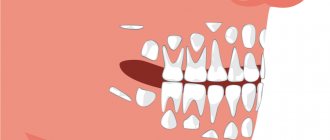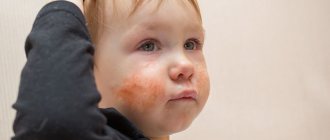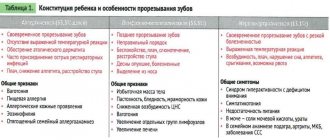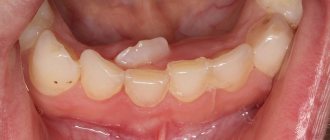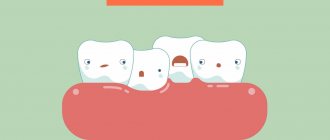How teeth are cut
Teething is a complex process, because at this time tissues are formed, tooth roots grow, and gums are rebuilt. Moreover, teeth begin to form during pregnancy, starting from the 6th week. Around this time, calcium begins to be deposited in the tissues of future teeth.
Next comes the fun part – teething. It is considered normal if teeth begin to cut between 4 and 7 months. But every body is unique, so everyone cuts their teeth differently. It depends on many things, for example:
- From genetics. Often the age at which a child begins to cut teeth depends on when his relatives - mom, dad, grandparents - started cutting teeth.
- From nutrition. If your baby doesn't have enough vitamins and minerals, such as vitamin C or calcium, his teeth will start cutting later.
- From the course of pregnancy. If there was fetal toxicosis during pregnancy, this will also slow down the appearance of teeth.
And normally, teeth are cut in pairs, that is, the lower central incisors appear first, then the upper central incisors, the upper lateral incisors - the lower lateral incisors, the upper first molars - the lower first molars, etc. But even if the order is disrupted, this does not always mean any illness or serious violation.
Ways to relieve discomfort
To make teething easier for your baby, you need to:
- provide additional attention and care from parents;
- if the baby is breastfed, put him to the breast more often, as this has a slight sedative effect;
- purchase several silicone teethers that can be cooled and offered to the child throughout the day;
- massage the gums with a finger wrapped in a clean gauze swab or a special silicone nozzle;
- promptly blot away any saliva with a clean napkin to avoid irritation of the skin around the mouth;
- if necessary and in consultation with a doctor, use medications.
Today, there are pharmacological and non-pharmacological methods of therapy for the eruption of primary teeth.
Local preparations
As a symptomatic aid for severe discomfort associated with teething, the pediatrician prescribes gels and ointments.
Such gels and ointments for teething with proven effectiveness are divided into 3 groups [1]:
- Preparations with an anesthetic effect based on anesthetic (lidocaine, choline, benzocaine). Sometimes lidocaine-based drugs contain anti-inflammatory or antiseptic components, providing a combined effect of the gel.
- Medicines based on anti-inflammatory or antiseptic agents.
- Preparations based on medicinal plant extracts. They use extracts of Roman chamomile, boswellia, aloe, marshmallow, Indian ivy, rhubarb, calendula and other components of plant origin.
Homeopathic remedies for teething are also produced, but their effectiveness has not been scientifically proven [1].
Systemic drugs
In cases of severe pain and hyperthermia, non-steroidal anti-inflammatory drugs are used, which reduce body temperature and have a systemic analgesic effect. The dosage and drug suitable for the child should be selected by a pediatrician.
Distractions
These include: the gum massage described above and baby teethers, which help the child temporarily reduce itching in the gums.
When to sound the alarm
In those places where teeth erupt, many biologically active substances are released, for example, histamine, leukotrienes, prostaglandins, etc. They cause the symptoms that every parent is familiar with:
- Temperature increase. Normally, when teething, the temperature should be low-grade, that is, no more than 38 degrees;
- Swelling, pain and redness of the gums.
This is a normal baby reaction to teething. As a rule, the baby refuses to eat, but at the same time pulls toys into his mouth to chew on them. Due to the fact that the child constantly chews something, the nerves of the gums are irritated and a lot of saliva is released, and since the child does not yet know how to control saliva, it flows out of the mouth. The child also becomes more excitable than usual - he sleeps less, is constantly capricious, and becomes irritable.
Life hack: to help your child and relieve tooth pain, buy a special teething toy. This toy can be filled with water and placed in the refrigerator. When the baby chews on it, the toy will cool the inflamed gums and thereby partially relieve the pain.
But there are symptoms that parents often confuse with a normal reaction to the appearance of teeth:
— Digestive disorders – diarrhea, vomiting, loose stools;
— Temperature above 38-39 degrees, which does not subside for several days;
- Cough, rash, swelling.
These symptoms indicate that there is an infection in the child’s body that needs to be treated.
Symptoms of teething in a baby:
- ♦The gums are red/white and swollen;
- ♦Salivation has clearly increased;
- ♦Redness/rash appeared around the mouth (due to a large amount of saliva);
- ♦The baby pulls into his mouth and bites all kinds of objects (rattles, pens, daddy’s glasses);
- ♦A runny nose may appear;
- ♦Slight dilution of stool (again due to increased salivation);
- ♦Appetite may worsen (due to pain in the mouth);
- ♦And also the baby has become noticeably more capricious, his sleep is more restless, his mother’s warmth and care are more needed (“hangs in his arms”).
It is important to remember that this period is temporary and will end. Be patient, gather your willpower and try to help your child survive this process. The mother’s actions to permanently return the former dream to the family are the same as during the child’s illness.
And now the important information. Key, I would say! Attention!
Rules for caring for emerging teeth
To clean infants' teeth, use special silicone fingertips with soft bristles. Toothpaste must be labeled to indicate that it is suitable for young children and does not contain substances that are hazardous if swallowed: high concentrations of fluorides, parabens, sodium lauryl sulfate.
As soon as the first tooth appears above the gum surface, it requires special care . The enamel has not yet fully formed, it is very thin, so childhood caries develops rapidly. Only 10% of children succeed in avoiding caries, and it is almost impossible for adults to avoid caries [5]. Therefore, you should not postpone the preventive fight against it.
To maintain the health of baby teeth, some of which will remain with the child until 10-12 years old, it is important to regularly visit the dentist once every 3-4 months. After a year, it is necessary to visit an orthodontist to make sure that the bite is developing correctly.
List of sources
1. Zaplatnikov A. L., Kasyanova A. N., Maykova I. D. Teething syndrome in infants: a new look at an old problem 2018 // https://www.rmj.ru/articles/pediatriya/Sindrom_prorezyvaniya_zubov_u_mladencev_novyy_vzglyad_na_staruyu_problemu / (date of access: 05/28/2020).
2. Zakharova I. N., Kholodova I. N., Dmitrieva Yu. A., Morozova N. V., Mozzhukhina M. V., Kholodov D. I. Can the physiological process of teething in infants be pathological? 2016 // https://cyberleninka.ru/article/n/mozhet-li-fiziologicheskiy-protsess-prorezyvaniya-zubov-u-mladentsev-byt-patologicheskim (date of access: 05/28/2020).
3. Kleshchenko E. I., Zhdanova I. A., Lukisha A. N., Krakovets I. V., Smychkova E. V., Kartavtseva A. V. Symptoms of teething in infants: condition or disease? 2022 // https://cyberleninka.ru/article/n/simptomy-prorezyvaniya-zubov-u-mladentsev-sostoyanie-ili-bolezn (date of access: 05/28/2020).
4. Kiselnikova L.P., Drobotko L.N. Eruption of primary teeth in children // https://cyberleninka.ru/article/n/prorezyvanie-vremennyh-zubov-u-detey 2017 (date of access: 28.05. 2020).
5. 90 percent of children and 100 percent of adults suffer from caries, Komsomolskaya Pravda, 09/04/2016 // URL: https://www.kp.ru/daily/26429.7/3300802/ (access date: 07/21/2020).
Medicines that change stool color
This symptom may be a side effect when using certain categories of medications. Stool becomes discolored due to the liver's reaction to certain medications. They may be:
- Paracetamol
- Acetylsalicylic acid derivatives: Aspirin, Laspal
- Non-steroidal anti-inflammatory drugs: Ibuprofen, Diclofenac, Nimesulide
- Antifungal: Griseofulvin
- Antiepileptic drugs: Acediprol, Valproic acid, Convulex, Leptilan
If such a reaction to the use of drugs occurs, you should consult with the specialist who prescribed the treatment in order to avoid complications for the liver and gastrointestinal tract.
Light-colored stools are a reason to get tested for hepatitis
Hepatitis can cause changes in a child's stool.
It is this reason that the child’s parents try to exclude when they see white stool, which is one of the signs of infection with the hepatitis virus. In addition, the following symptoms may be present:
- darkening of urine (dark beer color)
- pain in the right upper abdomen and severe bloating
- yellowing of the skin
- yellowing of the sclera of the eyes
- loss of appetite
- nausea
- heat.
To clarify the diagnosis, you need to contact a pediatrician or infectious disease specialist. Most likely, they will order laboratory tests to clarify the diagnosis. Hepatitis can also have a smoothed course, when there are no other symptoms except increased fatigue and pain in the right hypochondrium.
Changing your diet as a cause of light stools
The appearance of light-colored stools is usually very alarming for parents, but often the reason for this may simply be changes in the children's menu. Most often this is the consumption the day before of a large amount of dairy food with a high percentage of fat content - undiluted homemade milk, cream, cottage cheese, sour cream, fermented milk drinks. They can give the stool a light yellow or light cream tint.
The same color of stool may appear when a child eats a large amount of sweets. If the child feels well, does not show anxiety, there is no fever or abdominal pain, it is worth observing the stool for 1-2 days. Usually, after adjusting the diet, this symptom disappears.
Dysbacteriosis and light stools
Dysbacteriosis in children can occur after taking antibiotics.
One of the side effects of taking antibiotics can be dysbiosis - a change in the balance of microflora in the intestines and stomach towards the predominance of pathogenic bacteria. This condition is manifested by a violation of the usual stool consistency, alternating diarrhea and constipation, and the appearance of light-colored stools with pieces of undigested food and mucus.
Loss of appetite, restless sleep, weight loss due to dysbiosis are also common. You should not attempt to correct this condition on your own; you should consult a gastroenterologist.
Most likely, he will advise taking prebiotics (Lactobacterin, Bifidumbacterin, Acipol), after which the stool should take on a normal color and consistency.
